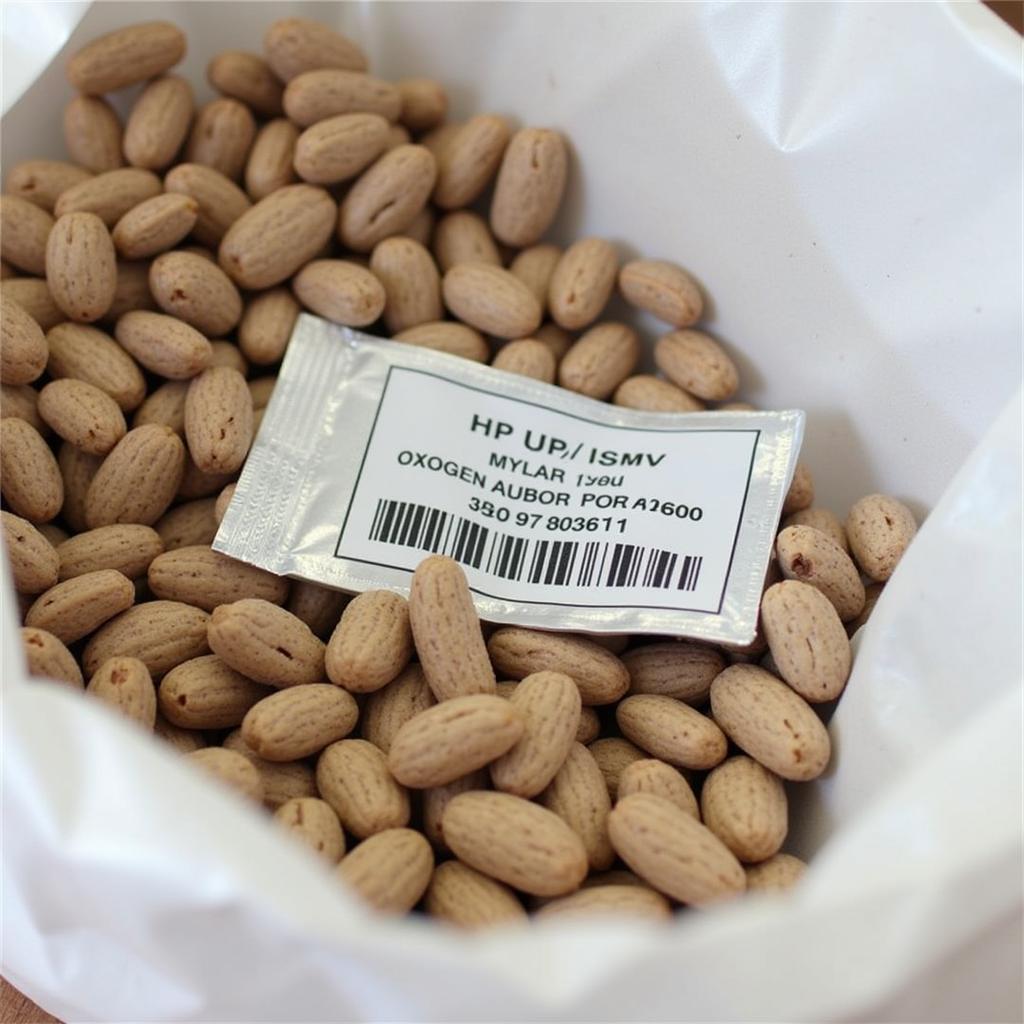Storing food in mylar bags with oxygen absorbers is a popular method for long-term food preservation. But just How Long Will Food Last In Mylar Bags? This comprehensive guide will delve into the factors affecting shelf life, the types of food suitable for mylar storage, and tips for maximizing the longevity of your precious supplies.
Understanding the Shelf Life of Food in Mylar Bags
Mylar bags, when combined with oxygen absorbers, create an oxygen-free environment that significantly slows down the degradation process of food. This isn’t magic, however, and several factors influence how long your food will remain edible. These include the type of food, initial quality, storage temperature, and proper sealing techniques. Thinking of storing dried food for survival? Mylar bags can be a game-changer.
While some foods can last for decades, others might only last a few years. For instance, properly stored dried beans in mylar bags can last for 5-10 years, while white rice can last for an impressive 30 years or more. Understanding these differences is crucial for effective food storage. Food storage in mylar bags offers a substantial advantage over traditional methods.
Factors Affecting Food Longevity in Mylar
- Initial Food Quality: Starting with high-quality, dry goods is essential. The lower the moisture content, the longer the food will last.
- Oxygen Removal: Using appropriate oxygen absorbers food storage is crucial for creating the oxygen-free environment that inhibits spoilage.
- Storage Temperature: Cooler temperatures significantly extend shelf life. Ideally, aim for a stable temperature below 70°F. Fluctuations in temperature can lead to condensation inside the bags, promoting mold growth.
- Light Exposure: Mylar bags are excellent at blocking light, but further protection by storing them in food storage 5 gallon buckets or a dark pantry helps preserve nutrients and flavor.
- Proper Sealing: Ensure the mylar bags are properly sealed using a heat sealer or robust tape to prevent oxygen and moisture from entering.
Which Foods Thrive in Mylar Storage?
Dried goods are ideal candidates for mylar storage. These include:
- Grains: Rice, wheat, oats, corn, etc.
- Legumes: Beans, lentils, peas
- Seeds: Sunflower, pumpkin, chia
- Pasta: Dried pasta
- Powdered Milk: Store in a cool, dry place
- Dehydrated Fruits and Vegetables: Properly dried produce can last for years.
Foods Less Suitable for Long-Term Mylar Storage
While mylar bags are versatile, certain foods aren’t ideal for extended storage:
- Oily Foods: Nuts and seeds with high oil content can go rancid even in mylar bags.
- Sugary Foods: Brown sugar and other sugary items can clump and harden.
- Canned Goods: Canned goods already have a long shelf life and don’t benefit significantly from mylar storage.
Maximizing Shelf Life: Best Practices for Mylar Bag Food Storage
- Inspect Your Food: Before sealing, ensure your food is free of pests or signs of spoilage.
- Use the Correct Size Oxygen Absorbers: The size of the oxygen absorber depends on the size of the mylar bag and the volume of food being stored.
- Double Bagging: Consider double bagging for extra protection against punctures and moisture.
- Label and Date: Clearly label each bag with the contents and the date of storage.
- Rotate Your Stock: Practice FIFO (First In, First Out) to ensure you’re using the oldest food first.
Conclusion
Storing food in mylar bags can significantly extend the shelf life of your supplies, providing peace of mind and security. By understanding the factors that affect longevity and following best practices, you can ensure your food remains edible and nutritious for years to come. How to use mylar bags for food storage is a skill worth mastering. Properly utilizing mylar bags and oxygen absorbers will maximize the shelf life of your stored food.
 Sealed Mylar Bags with Oxygen Absorbers
Sealed Mylar Bags with Oxygen Absorbers
FAQ
- Do I need oxygen absorbers with mylar bags for food storage? Yes, oxygen absorbers are essential for creating the oxygen-free environment that prevents spoilage.
- Can I reuse mylar bags? No, mylar bags are typically single-use. Once opened, they lose their oxygen barrier properties.
- What is the best way to seal mylar bags? A heat sealer is the most effective way to seal mylar bags, creating an airtight seal.
- Where should I store mylar bags with food? A cool, dry, and dark place is ideal for storing mylar bags with food.
- How can I tell if the food in mylar bags has gone bad? Signs of spoilage include mold growth, foul odors, and changes in texture or color.
- What is the typical shelf life of dried beans stored in mylar bags? Dried beans stored properly in mylar bags can last for 5-10 years.
- How long does rice last in mylar bags? Rice can last for an impressive 30 years or more when stored correctly in mylar bags with oxygen absorbers.
Common Storage Scenarios
- Emergency Preparedness: Mylar bags are invaluable for building a long-term emergency food supply.
- Everyday Pantry Storage: Extend the shelf life of your regular pantry staples like rice, beans, and grains.
- Camping and Backpacking: Lightweight and durable, mylar bags are a great option for preserving food on outdoor adventures.
Further Reading
For more information on food storage, check out our articles on dried food for survival and using 5-gallon buckets for food storage.
Need Help?
For assistance, please contact us at Phone Number: 02437655121, Email: minacones@gmail.com Or visit our address: 3PGH+8R9, ĐT70A, thôn Trung, Bắc Từ Liêm, Hà Nội, Việt Nam. We have a 24/7 customer service team.